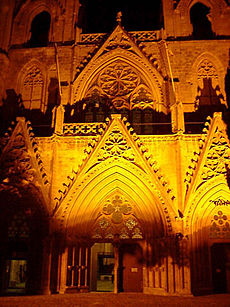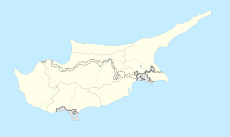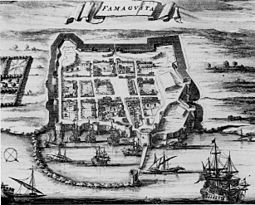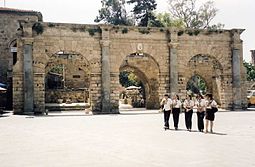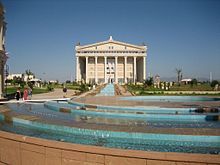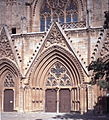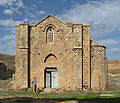- Famagusta
-
- "Magusa" redirects here. For the moth genus, see Magusa (moth).
Famagusta Αμμόχωστος (Greek) Gazimağusa/Mağusa (Turkish) Coordinates: 35°7′0″N 33°57′0″E / 35.116667°N 33.95°E Country De jure  Cyprus
Cyprus
De facto Northern Cyprus
Northern CyprusDistrict De jure Famagusta District
De facto Gazimağusa DistrictPopulation (30 April 2006 SPO census [1]) - Total 35,453 Time zone EET (UTC+2) Famagusta (Greek: Αμμόχωστος Ammóchōstos , Turkish: Gazimağusa/Mağusa) is a city on the east coast of Cyprus and is capital of the Famagusta District. It is located east of Nicosia, and possesses the deepest harbour of the island.
Contents
Name
In antiquity, the town was known as Arsinoe (Greek: Ἀρσινόη), after Arsinoe II of Egypt, and was mentioned by that name by Strabo. In Greek it is called Ammochostos, meaning "hidden in sand". This name developed into Famagusta (originally Famagouste in French and Famagosta in Italian ), used in Western European languages and the Turkish name, Mağusa. In fact, its Turkish name is Gazi-Mağusa (Gazi is a Turkish prefix meaning veteran, and was awarded officially after 1974; compare Gaziantep.). Turks not of Cypriot origin tend to call the city 'Magosa' to the dismay of the local Famagustans who continue to call their city Mağusa. The old town has been nicknamed "The city of 365 churches" owing to a legend that at its peak, Famagusta boasted one church for each day of the year.
History
Founded in 300 BC on the old settlement of Arsinoe, Famagusta remained a small fishing village for a long period of time. Later, as a result of the gradual evacuation of Salamis, it developed into a small port.
Medieval Famagusta, 1192-1571
 Othello's tower in Famagusta.
Othello's tower in Famagusta.
The turning point for Famagusta was 1192 with the onset of Lusignan rule. It was during this period that Famagusta developed as a fully-fledged town. It increased in importance to the Eastern Mediterranean due to its natural harbour and the walls that protected its inner town. Its population began to increase. This development accelerated in the 13th century as the town became a centre of commerce for both the East and West. An influx of Christian refugees fleeing the downfall of Acre (1291) in Palestine transformed it from a tiny village into one of the richest cities in Christendom. In 1372 the port was seized by Genoa and in 1489 by Venice. This commercial activity turned Famagusta into a place where merchants and ship owners led lives of luxury. The belief that people's wealth could be measured by the churches they built inspired these merchants to have churches built in varying styles. These churches, which still exist, were the reason Famagusta came to be known as "the district of churches". The development of the town focused on the social lives of the wealthy people and was centred upon the Lusignan palace, the Cathedral, the Square and the harbour.
Ottoman Famagusta, 1571–1878
In 1570-1571, Famagusta was the last stronghold in Venetian Cyprus to hold out against the Turks under Mustafa Pasha. It resisted a siege of thirteen months and a terrible bombardment, until at last the commander, Marco Antonio Bragadin was flayed alive, his lieutenant Tiepolo was hanged. [1] Lord Kinross, in his book, The Ottoman Centuries, describes the situation before the siege as follows:
The Venetians had for some time neglected this far eastern outpost of their Mediterranean dominions, and its population had greatly declined. The bulk of it was composed of Greek Orthodox peasants who were oppressed by the Frankish ruling class, and it was estimated that there were some fifty thousand serfs who would be ready to join the Turks. Sultan Selim (II) in a firman, or decree, now instructed his neighbouring sanjak bey to do his utmost to win the hearts of the masses, adding a solemn promise that in the event of the island's capture the population would not be molested and their property would be respected. Such was a formula, here strictly observed, which had for long preceded acts of Turkish expansion.
He describes the situation of the island after the fall of Famagusta as follows:
Venice was to cede the island to the Sultan two years later in a peace treaty which allowed for compensation sufficient to cover the cost of its conquest. Its subsequent administration was enlighted enough, following the standard Ottoman practice at this time in conquered territories. The former privileges of the Greek Orthodox Church were revived at the expense of the Latin Catholics, and its property restored to it. The Latin system of serfdom was abolished. The land which had formerly belonged to the Venetian nobility was transferred to the Ottoman state. The local inhabitants were assisted by the development of economic and financial resources. Large numbers of immigrants were brought from central Anatolia, with their cattle and farming implements, to settle in the empty islands.
At last, after the great calamity which had reduced the island to misery, somehow or other the poverty-stricken inhabitants began little by little to address themselves again to the culture of the soil, to some small commerce with strangers, and to those few arts which still survived in the he towns. At the very beginning the dues and outgoings did not press so very had on the rajah, because the Porte knew how the country had been impoverished by the war: and the Pashas sent to govern it were to some extent controlled by the Porte, lest their harshness should drive the rajah to leave the island, or at least to revolt, for which his degraded condition would be an excuse. So that after fifteen or twenty years the Christians redeemed nearly all the monasteries from those who had seized them, and much of the church lands as well. Churchmen of position left money for masses for the repose of their souls, or bestowed it by way of gifts.
Changes in social and cultural life had a major effect on the architectural and physical environment. In order to adjust to the socio- economic and cultural traditions of the new inhabitants, some changes were made to existing buildings. Only the main cathedral was turned into a mosque (Lala Mustafa Pasha Mosque), and the bazaar and market place were developed. Meanwhile a theological school, baths and fountains were built to fulfill basic daily needs. With the importation of dead end streets from Ottoman culture, the existing organic town structure was enriched and a communal spirit began to assert itself. The few two-storey houses inhabited by the limited number of wealthy people balanced harmoniously with the more common one-storey houses.
British rule, 1878-1960
In the British period, the port regained significance. The enlargement of the town outside the city walls in the Ottoman period accelerated. In this period, the Turkish population generally settled in the inner town while the Greek population settled in lower and upper Varosha. In tune with their colonial policies, the British set up an administrative base between the Turkish and Greek quarters rather than following the convention of establishing a base in the inner town. As a result, the enlargement of the town was increasingly centred around the Varosha district. Towards the end of the British period, in parallel with socio-economic developments, and in order to meet the changing needs of the population, new residential districts were built, incorporating new housing, commercial, touristic and recreational areas. Varosha was developed in large part as a tourist resort.
In this period, the town underwent a change reflecting the then current colonial practices. The influence of British architecture was particularly apparent in the form, the details and the materials used. The British, who believed in getting close to communities under their rule by using local materials and details, employed the same practice in Famagusta. The Cyprus Government Railway, with the head offices located in Famagusta, is said to have transformed Famagusta from an old Turkish town into a modern harbour city of the Levant.
The city was also the site for one of the two British internment camps for nearly 50.000 Jewish survivors of the Holocaust trying to emigrate to the British Mandate of Palestine. The other camp was located at Xylophaghou (see Jews in British camps on Cyprus).
After Independence, 1960-1974
From independence in 1960 to the Turkish invasion of Cyprus of 1974, Famagusta flourished both culturally and economically. The town developed toward the south west of Varosha as a tourist centre. In the late 1960s Famagusta became one of the world's best-known entertainment and tourist centres. On the one hand there were structures conveying the characteristics of British colonialism, and, on the other hand, buildings reflecting trends in contemporary architecture. These modern buildings were mostly built in Varosha. Architecture in Famagusta in this period thus reflects a desire to merge history and modernism in the pursuit of progress. From its origins as a small port in the seventh century, Famagusta in the 1970s had become a town which now displayed the universal trends of the modern architectural movement.
The contribution of Famagusta to the country’s economic activity by 1974 far exceeded its proportional dimensions within the country. Apart from possessing over 50% of the total accommodation of Cyprus it also offered the most substantial deep-water port handling (1973) 83% of the total general cargo and 49% of the total passenger traffic to and from the island. Whilst its population was only about 7% of the total of the country, Famagusta by 1974 accounted for over 10% of the total industrial employment and production of Cyprus, concentrating mainly on light industry compatible with its activity as a tourist resort and turning out high quality products ranging from food, beverages and tobacco, to clothing, footwear, plastics, light machinery and transport equipment.
As capital of the largest administrative district of the country, the town was the administrative, commercial, service and cultural centre of that district. The district of Famagusta before the 1974 invasion was characterized by a strong and balanced agricultural economy based on citrus fruits, potatoes, tobacco and wheat. Its agricultural success and the good communications between the town and the district ensured a balanced population spread and economic activity, which could be considered as a model for other developing areas.
It was inevitable that the material progress described above would spawn and sustain the most fertile kind of cultural activity in the area, with Famagusta as its hub and centre. Painting, poetry, music and drama were finding expression in innumerable exhibitions, folk art festivals and plays enacted in the nearby-reconstructed ruins of the ancient Greek theatre of Salamis.
There has not been an official census since 1960 but the population of the town in 1974 was estimated to be around 60,000 not counting about 12-15,000 persons commuting daily from the surrounding villages and suburbs to work in Famagusta. This population would swell during the peak summer tourist period to about 90-100,000 with the influx of tourists from numerous European countries, mainly Britain, France, Germany and Scandinavia.
1974
During the second phase of the Turkish invasion of Cyprus on 14 August 1974 the Mesaoria plain was overrun by Turkish tanks and in two days the Turkish Army occupied Famagusta. The town had been completely evacuated by its Greek Cypriot population who fled before the army's intervention.
Varosha
Unlike other parts of the non government controlled areas of Cyprus, the Varosha section of Famagusta was fenced off by the Turkish army immediately after being captured and still remains in that state today. The Greek Cypriots who had fled from Varosha were not allowed to return, and journalists are banned. It has been frozen in time with department stores and hotels empty but still fully equipped. Swedish journalist Jan-Olof Bengtsson, who visited the Swedish UN battalion in Famagusta port and saw the sealed-off part of the town from the battalion’s observation post, called the area a 'ghost town'. He wrote in Kvällsposten on September 24, 1977),
- "The asphalt on the roads has cracked in the warm sun and along the sidewalks bushes are growing [...] Today, September 1977, the breakfast tables are still set, the laundry still hanging and the lamps still burning [...] Famagusta is a ghost-town."
Since 1974
Turkish Cypriots continue to live north of Varosha, especially in the walled city. These sections of Famagusta remain vibrant with many fascinating buildings. The city is also home to the Eastern Mediterranean University.
The mayor-in-exile of Famagusta is Alexis Galanos. Oktay Kayalp heads the Turkish Cypriot municipal administration of Famagusta in the TRNC-controlled areas of Cyprus, while a Turkish Cypriot municipality is legal.[2] Since 1974, Greek Cypriots submitted a number of proposals within the context of bicommunal discussions for the return of Varosha to UN administration, allowing the return of its lawful inhabitants, requesting also the opening of Famagusta harbour for use by both communities. However, the Turkish Cypriot side and Turkey rejected them. Varosha would have been returned under Greek Cypriot control as part of the Annan Plan if the plan had been accepted by the Greek Cypriot voters.
The population of the city before 1974 was 39,000. Of this number, 26,500 were Greek Cypriots, 8,500 Turkish Cypriots and 4,000 from other ethnic groups. After the invasion, in 1975, the population was 8,500, all of them Turks. Today the population is 39,000, though this figure excludes the Greek Cypriot legal inhabitants.
Because of its isolation and neglect over the past 30 years despite being such a historically and culturally significant city, Famagusta was listed on the World Monuments Fund's 2008 Watch List of the 100 Most Endangered Sites in the world. Additionally, in an October 2010 report titled Saving Our Vanishing Heritage, Global Heritage Fund named Famagusta one of 12 sites most "On the Verge" of irreparable loss and destruction, citing insufficient management and development pressures.[3]
Education
In addition to the various Greek-speaking schools, prior to the Turkish invasion of 1974 Famagusta was home to the Famagusta Armenian school, which as of 1972 was called "Nareg". The school was founded in 1928 and was housed at various rented houses.[citation needed]
University education
In 1979 Eastern Mediterranean University which is the first[4] university in Cyprus was founded.
Hospitals And Medical Centers
Famagusta has three general hospitals. Gazimağusa Devlet Hastahanesi is the biggest hospital in city. It is a state hospital. Gazimağusa Tıp Merkezi and Gazimağusa Yaşam Hastahanesi are private hospitals.
Notable Famagustans
- Saint Barnabas, born and died in Salamis, Famagusta
- Dr. Derviş Eroğlu, current President of Northern Cyprus
- George Vasiliou, former President of Cyprus
- Alexia Vassiliou, famous singer
- Vamik Volkan, Emeritus Professor of Psychiatry
- Oktay Kayalp, current Turkish Cypriot Famagusta mayor (north Cyprus)
- Alexis Galanos, current Greek Cypriot Famagusta mayor (south Cyprus)
- Beran Bertuğ, Governor of Famagusta, first Cypriot woman to hold this position
- Derviş Zaim, award winning film director
Sister cities
City Country Year İzmir  Turkey
Turkey1974 Patras  Greece
GreeceSports
Football
Famagusta is represented by Mağusa Türk Gücü in Turkish Cypriot First Division. Dr. Fazil Kucuk Stadium is the largest football stadium in Famagusta[5]. Many Turkish Cypriot sport teams which left South Cyprus because of Cypriot intercommunal violence based in Famagusta.
Famagusta was home to many Greek Cypriot sport teams that left the city because of Turkish invasion. Most notably football clubs originally from the city are Anorthosis Famagusta FC of the Cypriot First Division as well as Nea Salamis Famagusta FC of the Cypriot Second Division who are now temporarily based in Larnaca.
Volleyball
Famagusta is represented by DAÜ Sports Club and Magem Sports Club in North Cyprus First Volleyball Division. Gazimağusa Türk Maarif Koleji represents Famagusta in North Cyprus High School Volleyball League[6].
Famagusta has a modern volleyball stadium which is called Mağusa Arena [7].
Gallery
Varosha
See also
- Salamis, Cyprus
- Famagusta District
- Gazimağusa District
References
- Sources consulted
- Cyprus.gov.cy (online). Republic of Cyprus government website.
- Enlart, Camille (1899). L'art gothique et la Renaissance a Chypre. Paris, pp. 251–255.
- Kyprianos (1788). History of Cyprus. Venice, p. 453
- Magusa.org (English). Official website of Famagusta.
- Smith, William (1854). Dictionary of Greek and Roman Geography. s.v. Arsinoe
- Endnotes
- ^ Magusa.org, op.cit., "Table-1: Population of Famagusta", as of April 2006
- ^ The Constitution - Appendix D: Part 12 - Miscellaneous Provisions
- ^ http://globalheritagefund.org/index.php/what_we_do/sites_on_the_verge/
- ^ http://www.emu.edu.tr/aboutemu/emuhistory.aspx
- ^ http://www.ktff.net/index.php?tpl=show_all_league&league_id=19
- ^ http://www.starkibris.net/index.asp?haberID=86296
- ^ http://gundem.emu.edu.tr/contents/index.php?option=com_content&view=article&id=64%3Amausa-arena-acildi&catid=44%3Aspor&Itemid=88&lang=tr
External links
Categories:- Famagusta
- 11th-century BC establishments
- Ancient Greek cities
- Ancient Greek sites in Cyprus
- Historic sites in Cyprus
- Mediterranean port cities and towns in Northern Cyprus
- Populated places in Famagusta District
- Populated places in Northern Cyprus
- Populated coastal places in Northern Cyprus
Wikimedia Foundation. 2010.

